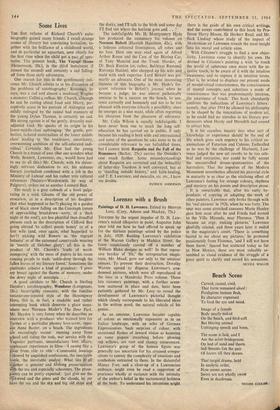Lorenzo with a Brush
Paintings of D. H. Lawrence. Edited by Mervyn Levy. (Cory, Adams and Mackay, 75s.) TOUCHED by the urgent impulse of D. H. Law- rence's naked allegories in paint, Augustus John once told me how he had offered to speak up for the thirteen paintings seized by the police in July, 1929. Raiding Lawrence's exhibition at the Warren Gallery in Maddox Street, the force suspiciously carried off a number of William Blake designs as well! In that repres- sive heyday of `Jix,' the octogenarian magis- trate, Mr. Mead, gave ear only to the amateur censors. To prevent their destruction, Dorothy Warren agreed to disperse Lawrence's con- demned pictures, which were all reproduced at the time in a Mandrake Press volume. Those late visionary paintings, with a further seven- teen scattered in place and date, have been patiently gathered by Mr. Levy to reveal the development of Lawrence's pictorial thought which closely corresponds to his liberated ideas in the written word, the natural vehicle of his genius.
As an amateur, Lawrence became capable of colour as emotionally expressive as in an Italian landscape, with an echo of German Expressionism. Such surprises of colour, with occasional flashes of inward vision as haunting as some pagans crouching before glowing red willows, are rare and chancy occurrences. Lawrence's grasp of the human figure was generally too uncertain for his strained compo- sitions to convey the complexity of emotions and symbolism entrusted to them. In the distasteful Mango Tree, and a close-up of a Lawrencian embrace, might even be read a suggestion of prurience wholly at variance with the intensity of the author's belief in the sacramental holiness of the body. To understand his intentions aright there is the guide of his own critical writings, and the essays contributed to this book by Pro- fessor Harry Moore, Sir Herbert Read, and Mr. lack Lindsay whose study of the impact of Modernism on Lawrence reveals the most insight into his moral and artistic aims.
With Cdzanne's struggle to find a new objec- tivity, Lawrence came to identify his own. He divined in Cdzanne's painting a wish `to touch the world of substance once more with the in- , tuitive touch, to be aware of it with the intuitive 'awareness, and to express it in intuitive terms. That is, he wished to displace our present mode of mental-visual consciousness, the consciousness of mental concepts, and substitute a mode of consciousness that was predominantly intuitive, the awareness of touch.' This book abundantly confirms the indications of Lawrence's letters: namely, that after 1914 he allowed his philosophy to be shaped by the innovations of modern art, as he could find no stimulus in his literary pre- decessors when Hardy and Meredith had ceased to attract him.
It is his ceaseless inquiry into what sort of knowledge or experience should be the end of life which gives such urgency to his critical ex- aminations of Futurism and Cubism. Enthralled as he was by the challenge of Marinetti, Law- rence judged the new art revolts to be too cele- bral and restrictive, nor could he fully accept the uncontrolled dream-spontaneities of the Surrealists. That the impulses of the Modern Movement nevertheless affected his pictorial style in maturity is as clear as the vitalising effect of Lawrence's feeling for strange colours, rhythms and mystery on his poems and descriptive prose.
It is remarkable that, after his early by- products of copying or adapting the work of other painters, Lawrence only broke through with his 'real pictures' in 1926, when he was forty. The spur was some stretched canvases Maria Huxley gave him soon after he and Frieda had moved to the Villa Mirenda, near Florence. 'Then it became an orgy, making pictures,' Lawrence gleefully related, and three years later it ended in the magistrate's court. 'There is something sacred to me about my pictures,' he protested passionately from Florence, 'and I will not have them burnt.' Spared but scattered today as far as New Mexico, these are most valuably as- sembled as visual evidence of the struggle of a great spirit to clarify and record his sensations.
NEVILE WALLIS






























 Previous page
Previous page